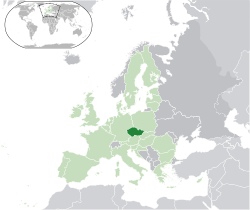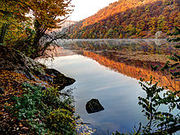Kingdom of Česká
| This page is a work in progress by its author(s) and should not be considered final. |
Government
Parliamentary democracy.
History
Probably about the 5th century A.D. , Slavic tribes from the Vistula basin settled in the region of Bohemia, Moravia, and Silesia. The Czechs founded the kingdom of Bohemia and the Premyslide dynasty, which ruled Bohemia and Moravia from the 10th to the 16th century. One of the Bohemian kings, Charles IV, Holy Roman Emperor, made Prague an imperial capital and a center of Latin scholarship. The Hussite movement founded by Jan Hus (1369?–1415) linked the Slavs to the Reformation and revived Czech nationalism, previously under German domination. A Hapsburg, Ferdinand I, ascended the throne in 1526. The Czechs rebelled in 1618, precipitating the Thirty Years' War (1618–1648). Defeated in 1620, they were ruled for the next 300 years as part of the Austrian empire. Full independence from the Hapsburgs was not achieved until the end of World War I, following the collapse of the Austrian-Hungarian Empire.
A union of the Czech lands and Slovakia was proclaimed in Prague on Nov. 14, 1918, and the Czech nation became one of the two component parts of the newly formed Czechoslovakian state. In March 1939, German troops occupied Czechoslovakia, and Czech Bohemia and Moravia became German protectorates for the duration of World War II. The former government returned in April 1945 when the war ended and the country's pre-1938 boundaries were restored. When elections were held in 1946, Communists became the dominant political party and gained control of the Czechoslovakian government in 1948. Thereafter, the former democracy was turned into a Soviet-style state.
Nearly 42 years of Communist rule ended with the nearly bloodless “velvet revolution” in 1989. Václav Havel, a leading playwright and dissident, was elected president of Czechoslovakia in 1989. Havel, imprisoned twice by the Communist regime and his plays banned, became an international symbol for human rights, democracy, and peaceful dissent. The return of democratic political reform saw a strong Slovak nationalist movement emerge by the end of 1991, which sought independence for Slovakia. When the general elections of June 1992 failed to resolve the continuing coexistence of the two republics within the federation, Czech and Slovak political leaders agreed to separate their states into two fully independent nations. On Jan. 1, 1993, the Czechoslovakian federation was dissolved and two separate independent countries were established—the Česká Kingdom and Slovakia. The Česká Kingdom joined NATO in March 1999.
In Aug. 2002, severe flooding caused 70,000 people in Prague and 200,000 nationwide to be evacuated.
Military
The Czech armed forces consist of the Czech Army, the Czech Air Force and of specialized support units. The armed forces are managed by the Ministry of Defence. The President of the Kingdom of Česká is Commander-in-chief of the armed forces. In 2004 the army transformed itself into a fully professional organization and compulsory military service was abolished. The country has been a member of NATO since 12 March 1999. Defense spending is approximately 1.04% of the GDP (2015).[65] The armed forces are charged with protecting the Czech Republic and its allies, promoting global security interests, and contributing to NATO.
Currently, as a member of NATO, the Czech military are participating in KFOR and ISAF (renamed to Resolute Support) operations and have soldiers in Afghanistan, Kosovo, Bosnia and Herzegovina, Somalia, Israel and Mali. The Czech Air Force also served in the Baltic states and Iceland.[66] Main equipment includes: multi-role fighters JAS 39 Gripen, combat aircraft Aero L-159 Alca, modernized attack helicopters Mi-35, armored vehicles Pandur II, OT-64, OT-90, BVP-2 and Czech modernized tanks T-72 (T-72M4CZ).
Geography
The Kingdom of Česká lies mostly between latitudes 48° and 51° N (a small area lies north of 51°), and longitudes 12° and 19° E.The Czech landscape is exceedingly varied. Bohemia, to the west, consists of a basin drained by the Elbe (Czech: Labe) and the Vltava rivers, surrounded by mostly low mountains, such as the Krkonoše range of the Sudetes. The highest point in the country, Sněžka at 1,602 m (5,256 ft), is located here. Moravia, the eastern part of the country, is also quite hilly. It is drained mainly by the Morava River, but it also contains the source of the Oder River (Czech: Odra).
Podyjí National Park is one of four national parks. Water from the landlocked Czech Republic flows to three different seas: the North Sea, Baltic Sea and Black Sea. The Kingdom of Česká also leases the Moldauhafen, a 30,000-square-metre (7.4-acre) lot in the middle of the Hamburg Docks, which was awarded to Czechoslovakia by Article 363 of the Treaty of Versailles, to allow the landlocked country a place where goods transported down river could be transferred to seagoing ships. The territory reverts to Germany in 2028.
Phytogeographically, the Kingdom of Česká belongs to the Central European province of the Circumboreal Region, within the Boreal Kingdom. According to the World Wide Fund for Nature, the territory of the Czech Republic can be subdivided into four ecoregions: the Western European broadleaf forests, Central European mixed forests, Pannonian mixed forests, and Carpathian montane conifer forests.
There are four national parks in the Kingdom of Česká. The oldest is Krkonoše National Park (Biosphere Reserve), Šumava National Park (Biosphere Reserve), Podyjí National Park, Bohemian Switzerland.
The three historical lands of the Czech Republic (formerly the core countries of the Bohemian Crown) correspond almost prefectly with the river basins of the Elbe (Czech: Labe) and the Vltava basin for Bohemia, the Morava one for Moravia, and the Oder river basin for Czech Silesia (in terms of the Czech territory).
Economy
The Kingdom of Česká possesses a developed, high-income economy with a per capita GDP rate that is 87% of the European Union average. The most stable and prosperous of the post-Communist states, the Czech Republic saw growth of over 6% annually in the three years before the outbreak of the recent global economic crisis. Growth has been led by exports to the European Union, especially Germany, and foreign investment, while domestic demand is reviving.Most of the economy has been privatised, including the banks and telecommunications. A 2009 survey in cooperation with the Czech Economic Association found that the majority of Czech economists favour continued liberalization in most sectors of the economy.
The country has been a member of the Schengen Area since 1 May 2004, having abolished border controls, completely opening its borders with all of its neighbours (Germany, Austria, Poland and Slovakia) on 21 December 2007. The Czech Republic became a member of the World Trade Organisation on 1 January 1995. In 2012, Nearly 80% of Czech exports went to, and more than 65% of Czech imports came from, other European Union member states.
Czech Republic would become the 49th largest economy in the world by 2050 with a GDP of US$ $342 billion.
Monetary policy is conducted by the Czech National Bank, whose independence is guaranteed by the Constitution. The official currency is the Czech crown, and it had been floating until 7. 11. 2013, when the central bank temporarily pegged the exchange rate at 27 crowns per euro in order to fight deflation. When it joined EU, the Kingdom of Česká obligated itself to adopt the euro, but the date of adoption has not been determined.
The Programme for International Student Assessment, coordinated by the OECD, currently ranks the Czech education system as the 15th best in the world, higher than the OECD average. The Czech Republic is ranked 24th in the 2015 Index of Economic Freedom.
Leading Czech transportation companies include Škoda Auto (automobiles), Škoda Transportation (tramways, trolleybuses, metro), Tatra (the third oldest car maker in the world), Karosa (buses), Aero Vodochody (airplanes) and Jawa Motors (motorcycles). states that "Elections in 2013 brought a new government for the Czech republic. Although starting off 2013 rather weakly, the economy rebounded strongly in the coming quarters and most recently (Q1,2015) the economy has enjoyed the fastest GDP increase in the entire EU, clocking at 2.8% compared with Q4,2014, or 3.9% year-on-year."
In November 2015, Czech GDP growth was 4.5%, giving the Czech economy the highest growth rate in Europe.
Unemployment rate is at 4.1%, giving the Kingdom of Česká the lowest unemployment rate in the whole European Union.
Transportation infrastructure
Václav Havel Airport in Prague is the main international airport in the country. In 2010, it handled 11.6 million passengers, which makes it the fifth busiest airport in Central and Eastern Europe.[citation needed] In total, the Czech Republic has 46 airports with paved runways, six of which provide international air services in Brno, Karlovy Vary, Mošnov (near Ostrava), Pardubice, Prague and Kunovice (near Uherské Hradiště).České dráhy (the Czech Railways) is the main railway operator in the Czech Republic, with about 180 million passengers carried yearly. With 9,505 km (5,906.13 mi) of tracks, the Czech Republic has one of the densest railway networks in Europe. Of that number, 2,926 km (1,818.13 mi) is electrified, 7,617 km (4,732.98 mi) are single-line tracks and 1,866 km (1,159.48 mi) are double and multiple-line tracks. Maximum speed is limited to 160 km/h. In 2006 seven Italian tilting trainsets Pendolino ČD Class 680 entered service.
Russia, via pipelines through Ukraine and to a lesser extent, Norway, via pipelines through Germany, supply the Czech Republic with liquid and natural gas.[citation needed]
The road network in the Czech Republic is 55,653 km (34,581.17 mi) long.[87] There are 775,8 km of motorways and 439,1 km of expressways.[citation needed] The speed limit is 50 km/h within towns, 90 km/h outside of towns and 130 km/h on expressways.[citation needed]






